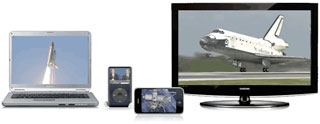 Orbiter: Endeavour Mission: STS-130 Payload: Tranquility Launch: Feb. 7, 2010 Time: 4:39 a.m. EST Site: Pad 39A, Kennedy Space Center Landing: Feb. 19 @ approx. 11:15 p.m. Site: KSC's Shuttle Landing Facility 

|
Mission Status Center
Welcome to Spaceflight Now's live coverage of space shuttle Endeavour's STS-130 mission to the International Space Station. Text updates will appear automatically; there is no need to reload the page. Follow us on Twitter. TUESDAY, FEBRUARY 9, 2010
An Atlas 5 rocket was rolled to its Cape Canaveral pad this morning for Wednesday's launch of the Solar Dynamics Observatory, a NASA spacecraft that will stare directly at the Sun continuously for the next decade to observe the star's behavior and how it influences life on Earth.
1339 GMT (8:39 a.m. EST) We will provide extensive live countdown and launch coverage Wednesday morning the Mission Status Center page. 1303 GMT (8:03 a.m. EST)
The Atlas 5 rocket that will launch NASA's Solar Dynamics Observatory from Cape Canaveral tomorrow is rolling to launch pad. Watch it live in our Mission Status Center.
1255 GMT (7:55 a.m. EST)
All of the work slated for Flight Day 2 has been accomplished by the astronauts. They'll be heading into an 8-hour sleep period at 9:14 a.m. EST.
1159 GMT (6:59 a.m. EST)
The crew has extended the docking ring that will connect the shuttle's port to the space station, setting up the springs and shock absorbers to do their roles during the link. The astronauts also set up the centerline camera in the docking port to be used in the final approach.
1150 GMT (6:50 a.m. EST)
Endeavour's reaction control jets have been fired for the latest course correction maneuver on the path to reach the space station. This burn lasted six seconds and changed the shuttle's velocity by about 1.4 feet per second.
The shuttle's new orbit is 215 miles at apogee and 187 miles at perigee. Endeavour is trailing the space station by about 900 miles. Docking is scheduled for 12:06 a.m. EST tonight. 1103 GMT (6:03 a.m. EST)
The Orbiter Boom Sensor System is being locked down in the payload bay, its job of inspecting Endeavour's heat shield complete for today. The boom will be used again late in the mission for another round of observations to check for space debris impacts before Endeavour comes home.
1035 GMT (5:35 a.m. EST)
The spacewalking suits carried on Endeavour for transfer over the space station have been checked out without any problems reported.
1030 GMT (5:30 a.m. EST)
See our full story from today's mission status briefing.
1011 GMT (5:11 a.m. EST)
The port wing sweeps by the inspection boom have been completed by the crew. It will take a day or two for ground analysts to review the data and declare the heat shield safe for re-entry.
The astronauts will return the 50-foot-long structure back into its cradle in the payload bay a short time from now. A few highlights remaining on the to-do list for this workday include installation of the centerline camera in the Orbiter Docking System to help commander George Zamka during Tuesday night's approach to the space station, a checkout of the rendezvous tools and the docking ring will be extended in preparation for linkup with the station's Harmony module. The crew is scheduled for sleep at 9:14 a.m. EST. 0914 GMT (4:14 a.m. EST)
While conducting the port wing inspections, the image from the sensor package suddenly went blank on the equipment inside Endeavour and on the ground. Terry Virts spent the past few minutes working with Houston to get the system back online. And now the survery has resumed.
0830 GMT (3:30 a.m. EST)
The mission's spacewalkers are working down on the middeck to test and ready the spacesuits to be worn during upcoming excursions outside the International Space Station.
0756 GMT (2:56 a.m. EST)
Post-launch checks of the reinforced carbon-carbon panels on the leading edge of Endeavour's port wing are underway by Kay Hire and Terry Virts.
Mission Control says the crew is running about 40 minutes behind the timeline. 0738 GMT (2:38 a.m. EST)
The crew has finished the nose cap survey already. The left wing inspections are next up in this multi-hour job to survey the shuttle to look for any signs of launch damage. The precautionary safety inspection has become a standard activity for all post-Columbia shuttle crews.
0648 GMT (1:48 a.m. EST)
The astronauts have swung the inspection boom into position out in front of Endeavour to get a closeup look on the shuttle's nose cap. The astronauts now working the heat shield survey activities at this point in the day are commander George Zamka, pilot Terry Virts and flight engineer Steve Robinson.
0630 GMT (1:30 a.m. EST)
Awe-inspiring pictures of space shuttle Endeavour's thunderous blastoff. Check them out!.
0626 GMT (1:26 a.m. EST)
Inspections of space shuttle Endeavour's starboard wing just finished. The extensive imagery and laser data will be analyzed by specialists on the ground to determine if the spacecraft's heat shield is safe for re-entry.
0600 GMT (1:00 a.m. EST)
What's the schedule of activities throughout Endeavour's mission? Check out the latest version of the flight plan.
0550 GMT (12:50 a.m. EST)
Sweeping back and forth, back and forth, the inspection device is looking for any signs of damage to to the leading edge of Endeavour's starboard wing that could have occurred during ascent yesterday. 0501 GMT (12:01 a.m. EST)
The Orbiter Boom Sensor System, anchored on the end of shuttle Endeavour's robot arm, has been positioned to begin today's heat shield inspections. Scans on the starboard side of the shuttle will be performed first.
The crew has completed the calibration and testing of the sensors. They also took imagery of the starboard plate where the launch pad umbilicals connect to the shuttle. 0340 GMT (10:40 p.m. EST Mon.)
The boom has been released from its cradle and raised out of the shuttle bay. The astronauts are working to activate the camera and laser sensor package on the boom that will scan the wings and nose of the orbiter over the next several hours.
0330 GMT (10:30 p.m. EST Mon.)
The Endeavour astronauts worked through a busy first day in space Monday evening after a pre-dawn climb into orbit, gearing up for a lengthy inspection of the shuttle's heat shield amid work to prepare for rendezvous and docking with the International Space Station overnight Tuesday.
Read our full story. 0323 GMT (10:23 p.m. EST Mon.)
The latest version of the NASA Television schedule (Rev. C) can be downloaded here.
0321 GMT (10:21 p.m. EST Mon.)
Astronauts Kay Hire and Nick Patrick are working together on the aft flight deck of Endeavour to operate the shuttle's robotic arm. The arm just grabbed the Orbiter Boom Sensor System for its unberthing from the payload bay and today's inspections of the shuttle's heat shield.
0235 GMT (9:35 p.m. EST Mon.)
After waking up, having some breakfast and going through their morning routine, the Endeavour astronauts have gotten to work. They just completed the latest engine firing as part of the two-day rendezvous sequence to catch the space station.
The NC2 burn was executed using both Orbital Maneuvering System engines, changing the shuttle's speed by 104 feet per second during the 66-second firing. Coming up shortly will be the grappling of the inspection boom by the shuttle's robot arm. MONDAY, FEBRUARY 8, 2010
Mission Control has awakened the astronauts to begin Flight Day 2, the crew's first full day in orbit.
2315 GMT (6:15 p.m. EST) Today will be spent inspecting Endeavour's heat shield for any signs of launch damage, a routine task for shuttle crews. Other activities include checking out the spacesuits to be worn during the mission's spacewalks and preparing equipment for tomorrow night's docking to the space station. Read our earlier status center coverage. |
 Join Miles O'Brien, David Waters and Leroy Chiao for our live launch webcast from Kennedy Space Center starting at 12 a.m. EST on launch morning. 
Space video for your computer, iPod or big screen TV
Experience the space program like never before become a subscriber today |


